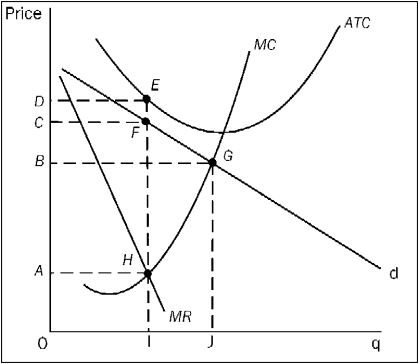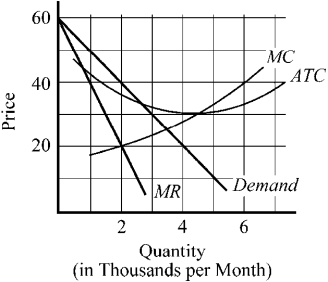A) will earn less profit than those that do not discriminate.
B) will earn more profit than those that do not discriminate.
C) are biased against certain buyers in the market.
D) will always produce less output than firms that do not discriminate.
Correct Answer

verified
Correct Answer
verified
Multiple Choice
In the long run,neither competitive price takers nor competitive price searchers will be able to earn economic profits because
A) entry barriers into these markets are high,raising the costs of each firm.
B) the government will dictate moderate prices for these firms.
C) competition will force prices down to the level of per-unit production costs.
D) marginal revenue is always less than marginal cost when barriers to entry are low.
Correct Answer

verified
Correct Answer
verified
Multiple Choice
Entrepreneurial judgment requires
A) the ability to use perfect information about the suture to your advantage.
B) the ability to discover new approaches or solutions to complex problems.
C) the use of government regulations to prevent competition
D) that a firm make a profit.
Correct Answer

verified
Correct Answer
verified
Multiple Choice
Price searchers can be expected to charge a price that
A) is the highest at which consumers will purchase any units.
B) they expect to provide the largest possible flow of gross revenue.
C) minimizes their per-unit costs of production.
D) maximizes their profit.
Correct Answer

verified
Correct Answer
verified
Multiple Choice
Long-run equilibrium in a competitive price-searcher market requires that
A) the demand curve intersect the average cost curve.
B) the demand curve be tangent to the average cost curve.
C) price be equal to marginal cost.
D) quantity produced be at the point where average cost is at a minimum.
Correct Answer

verified
Correct Answer
verified
Multiple Choice
A firm in a competitive price-searcher market faces
A) a horizontal demand curve at the market equilibrium price.
B) a horizontal demand curve at every price.
C) an upward-sloping demand curve.
D) a downward-sloping demand curve.
Correct Answer

verified
Correct Answer
verified
Multiple Choice
Assume a competitive price-searcher firm is earning an economic profit.The marginal revenue from selling an additional unit is $30 and the marginal cost of producing that additional unit is $23.The firm should
A) change neither its price nor its output level
B) reduce its price and increase its output level
C) increase its price and reduce its output level
D) reduce both its price and its output level
E) increase both its price and its output level
Correct Answer

verified
Correct Answer
verified
Multiple Choice
Suppose you were asked to determine whether a firm was a price taker or a competitive price searcher by looking at a graph of the firm's cost and revenue curves.The key is that for the competitive price searcher,
A) the firm's marginal revenue curve lies above and to the right of the demand curve,not below and to the left.
B) there are only total costs,not variable costs,on the graph.
C) the firm's demand curve is downward sloping,not a horizontal line.
D) all of the above are true.
Correct Answer

verified
Correct Answer
verified
Multiple Choice
A competitive price-searcher market is characterized by firms
A) being able to choose their price and by low barriers preventing firms from entering or leaving the market.
B) being able to choose their price and by high barriers preventing firms from entering or leaving the market.
C) having to accept the market price for their product and by high barriers preventing firms from entering or leaving the market.
D) having to accept the market price for their product and by low barriers preventing firms from entering or leaving the market.
Correct Answer

verified
Correct Answer
verified
Multiple Choice
Losses are important to a competitive price-searcher market (industry) because they send a message to the market participants that
A) more resources should be devoted to a particular industry.
B) resources can rise in value if diverted away from that particular industry.
C) resources are allocated exactly as they should be.
D) the firms should charge lower prices.
Correct Answer

verified
Correct Answer
verified
Multiple Choice
Other economists have argued that the allocative inefficiency of competitive price searchers apparent in mechanical models is misleading.They argue that such mechanical models fail to account for
A) the entry and exit of firms in the long run,which drives economic profits to zero,thereby eliminating any short-run,allocative inefficiencies in competitive price-searcher industries.
B) the possibility that the higher prices paid by consumers in competitive price-searcher industries are compensated by greater choice of goods or locations than would be present in an allocatively "efficient" industry.
C) the spillover effects on the advertising industry,which would shrink substantially if competitive price searchers did not need to advertise so much.
D) the fact that most competitive price-searcher industries are contestable markets,so competitive price searchers react to competitive pressures whether or not numerous competitors actually operate in the market.
Correct Answer

verified
Correct Answer
verified
Multiple Choice
Figure 10-14
 -Refer to Figure 10-14.This firm will maximize profits by producing a quantity of output equal to
-Refer to Figure 10-14.This firm will maximize profits by producing a quantity of output equal to
A) I and charging a price equal to A.
B) I and charging a price equal to C.
C) I and charging a price equal to D.
D) J and charging a price equal to B.
Correct Answer

verified
Correct Answer
verified
Multiple Choice
Figure 10-5
 -Given the cost and demand conditions shown in Figure 10-5 for the competitive price-searcher firm,what is the level of output it should produce to maximize its profit?
-Given the cost and demand conditions shown in Figure 10-5 for the competitive price-searcher firm,what is the level of output it should produce to maximize its profit?
A) 1
B) 2
C) 3
D) 4
Correct Answer

verified
Correct Answer
verified
Multiple Choice
For the competitive price searcher,
A) price will exceed marginal cost at the profit-maximizing level of output.
B) price will equal average total cost in the long run.
C) economic profit will be driven to zero in the long run by the entry and exit of firms.
D) all of the above are correct.
Correct Answer

verified
Correct Answer
verified
Multiple Choice
If the firms in a competitive price-searcher market are suffering short-run losses,which of the following will occur in the long run?
A) New firms will enter the industry.
B) Customers of firms that leave the industry will switch to remaining firms.
C) Firms that remain in the industry will face reduced demand.
D) Firms will continue to incur losses.
Correct Answer

verified
Correct Answer
verified
Multiple Choice
The fact that barriers to entry are low in competitive price-searcher markets means that if current firms are making economic losses,
A) these losses will remain in the long run because firms will not exit the market.
B) some current firms will exit the market,causing the demand curves that face the remaining firms to increase.
C) new firms will enter the market,causing the demand curves that face the existing firms to decrease.
D) new firms will enter the market,causing no change in the demand curves that face the existing firms in the market.
Correct Answer

verified
Correct Answer
verified
Multiple Choice
Which of the following is true?
A) Price takers will not be able to earn economic profits in the long run,but competitive price searchers will be able to do so.
B) Competitive price searchers will not be able to earn economic profits in the long run,but price takers will be able to do so.
C) Neither competitive price searchers nor price takers will be able to earn economic profits in the long run.
D) Both competitive price takers and price searchers will be able to earn economic profits in the long run.
Correct Answer

verified
Correct Answer
verified
Multiple Choice
A price searcher confronts a downward sloping demand curve because
A) products in the market are differentiated.
B) there is no close competitor in the market.
C) the market is essentially monopolized.
D) the firm gains nothing if it lowers its price.
Correct Answer

verified
Correct Answer
verified
Multiple Choice
A competitive price-searcher market is characterized by firms
A) being able to choose their price and no barriers preventing firms from entering or leaving the market.
B) being able to choose their price and high barriers preventing firms from entering or leaving the market.
C) being able to accept the market price for their product and high barriers preventing firms from entering or leaving the market.
D) having to accept the market price for their product and no barriers preventing firms from entering or leaving the market.
Correct Answer

verified
Correct Answer
verified
Multiple Choice
Airfares are generally cheaper if they include a Saturday night stay at the destination.This is because
A) hotels give the airlines kickbacks to price this way.
B) business travelers are less likely than leisure travelers to be willing to stay Saturday night away from home,and business travelers will generally have more inelastic demand for air travel.
C) business travelers are less likely than leisure travelers to be willing to stay Saturday night away from home,and business travelers will generally have more elastic demand for air travel.
D) this reduces the demand for travel on Saturdays,which is a high-cost day to fly airplanes.
Correct Answer

verified
Correct Answer
verified
Showing 141 - 160 of 216
Related Exams